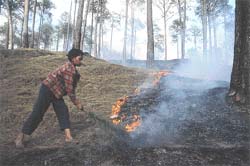Forests of fire
 The much-awaited rain arrived too late in the hills of Uttarakhand in Uttar Pradesh. Forest fires had already gutted more than 40,000 hectares of the 3,446,655-hectare forests in the region, mainly affecting pine forests. Three people died and several were injured in fighting fires in the Garhwal region in the first week of May, according to reports. Even by very conservative estimates, the damage is running into crores of rupees. And when the long-term impacts of the fires on the ecology are considered, the cost is incalculable (see chart: Forest fires and ecological destruction ).
The much-awaited rain arrived too late in the hills of Uttarakhand in Uttar Pradesh. Forest fires had already gutted more than 40,000 hectares of the 3,446,655-hectare forests in the region, mainly affecting pine forests. Three people died and several were injured in fighting fires in the Garhwal region in the first week of May, according to reports. Even by very conservative estimates, the damage is running into crores of rupees. And when the long-term impacts of the fires on the ecology are considered, the cost is incalculable (see chart: Forest fires and ecological destruction ).
"There has been virtually no rain since October 1998 and the heat was extreme. The pine forests were like a bomb. One spark and the whole forest could go up in flames,' says Kapil Joshi, divisional forest officer ( dfo ), Kumaon (east). Indeed, that is just what happened. Lok Man S Palni, director of the G B Pant Institute of Himalayan Environment and Development in Kosi, Almora, says the moisture content of the ground this year was even less than two per cent. According to a forest department ( fd ) official, the first fire was reported on March 16. Even after the rains in May, as the people and the authorities were trying to recoup from the scars of the inferno, fires were seen breaking out again in some parts of the hills.
A haystack of needles and its four-year cycle Pine forests are especially vulnerable to forest fires because of the needles that pine trees shed regularly. The needles fall in immense quantities and take extremely long to decompose (about 560 days). They are known as pirul in the local language, and have very little use, being acidic in nature. Yearly removal of pirul can account for 300-350 truckloads per hectare. However, their lack of use makes pirul even a greater menace. It lies like a massive carpet, spreading for many kilometres without a break. All it takes is one spark and there is an inferno.
Although the shedding of the needles take place throughout the year, maximum shedding takes place in April, explains D C Khanduri, deputy inspector general with the Union ministry of environment and forests, New Delhi. The needles keep accumulating every year, becoming a huge pile. fd carries out controlled burning every year to clear the ground of pirul . However, the accumulation continues. And by the fourth year, there is an immense amount of pirul .
"The pirul bed gets as thick as 24 centimetres. And when they are lighted, the fire can be very big,' says S P Subudhi, dfo , Almora. According to him, the extremely dry conditions added fuel to the fire, especially as 1999 is the fourth year of the cycle. The previous peak was in 1995, when fires affected 93,000 hectares of forests. If fd and civil authorities are aware of the four-year cycle, why were the fires allowed to get out of hand? "We try to grow forests, but we do not protect them,' acknowledges Palni.
Who is to blame? Fire in pine forests is an annual feature in Uttarakhand. Two factors are responsible for these fires: natural and human-made. Among the natural reasons, sparks from falling stones and boulders can light a bed of pirul . Another explanation is that there were emissions of natural gas in the region due to the earthquake, which accentuated the fires.
If the fires are
Related Content
- Global Assessment Report on Disaster Risk Reduction 2025
- Order of the National Green Tribunal regarding illegal felling of trees within the Badapari Demarcated Protected Forest (DPF), Khordha district, Odisha, 15/05/2025
- European State of the Climate Report 2024
- Order of the National Green Tribunal regarding dumping yard at Baliapanda, Puri district, Odisha, 24/03/2025
- Taming wildfires in the context of climate change: the case of the United States
- Natural climate solutions and fire mitigation: early findings on the path to net zero
